Focke-Wulf Ta 183 Video - Brief overview
|
|
Focke-Wulf Ta 183
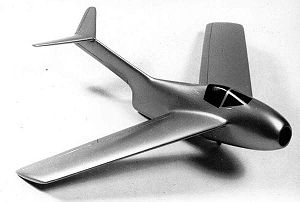
Picture - Wind tunnel model
Role: Fighter
Manufacturer: Focke-Wulf
Status: Teminated by end of war
Primary user: Luftwaffe
Number built: None completed
Developed into: FMA IAe 33 Pulqui II
The Focke-Wulf Ta 183 Huckebein (Hunchback) was a jet-powered fighter aircraft, designed during World War II as the successor to the Messerschmitt Me 262 and other day fighters in Luftwaffe service. It was developed only to the extent of wind tunnel models when the war ended, but the basic design was further developed post-war in Argentina as the FMA Pulqui II. The name Huckebein is a reference to a trouble-making comic strip raven.
Development
In early 1945, the Reichsluftfahrtministerium (RLM) became aware of Allied jet developments, and were particularly concerned that they might have to face the Gloster Meteor over the continent. In response, they instituted the Emergency Fighter Program, ending production of most bomber and multi-role aircraft in favor of fighters, especially jet fighters. Additionally, they accelerated the development of experimental designs that would guarantee a performance edge over the Allied designs, designs that would replace the first German jet fighters Messerschmitt Me 262 and Heinkel He 162.
The result was a series of advanced designs, some using swept wings for improved transonic performance, others instead using the tailless design to lower drag to the same end. Unknown to the engineers at the time, tailless designs have serious stability problems in the transonic, a problem first explored in depth in the X-4 Bantam. Kurt Tank's design team led by Hans Multhopp designed in 1945 a fighter known as "Huckebein" (a cartoon raven that traditionally makes trouble for others), also known as Project V (Project VI in some references) or Design II at Focke-Wulf.
Design
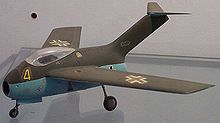
Picture - A Modell of Fw Super-Lorin
Development of the Ta 183 started as early as 1942 as Project VI, when the engineer Hans Multhopp assembled a team to design a new fighter, based on his understanding that previous Focke-Wulf design studies for jet fighters had no chance of reaching fruition because none had the potential for transonic speeds. The aircraft was intended to use the advanced Heinkel HeS 011 turbojet, although the first prototypes were to be powered by the Junkers Jumo 004B. Early studies also included an optional 1,000 kgf (10 kN) thrust rocket engine for takeoff and combat boost, much as the special "003R" version of the BMW 003 jet engine was meant to use, with fuel and oxidizer for up to 200 seconds of burn time stored in drop tanks under the wings.
Picture - A Model of Focke-Wulf Ta 183 Design II
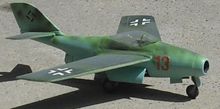
The wings were swept back at 40° and were mounted in the mid-fuselage position. The wings appear to be mounted very far forward compared to most designs, a side effect of attempting to keep the center of pressure (CoP) of the wing as a whole as close to the middle of the fuselage as possible. The main spar consisted of two tapered aluminum I-beams attached together on the top and bottom with thin steel sheeting. The box-like structure contained six fuel cells, giving the aircraft a total fuel load of 1,565 L (413 US gal). Wooden ribs were attached to the front and back of the I-beams to give the wing its overall shape, and then covered with plywood.
Picture - Ta 183 B
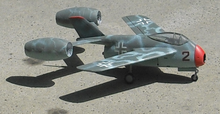
The original design used a T-tail, with a notably long vertical stabilizer and a seemingly undersized horizontal stabilizer. The vertical tail was swept back at 60°, and the horizontal tail was V-shaped and dihedralled. The horizontal surface was used only for trimming, the main pitching force being provided by the ailerons, which were well behind the center of gravity and thus could provide both pitch and roll control, functioning as elevon control surfaces. Many problems beset the project, including the chance of a Dutch roll. Work therefore concentrated on the much less problematical Focke-Wulf Project VII. However, when the RLM eventually rejected that design, Huckebein was again brought to the fore.
Picture - Final Ta 183 Design III
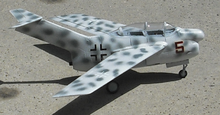
The Ta 183 had a short fuselage with the air intake passing under the cockpit and proceeding to the rear where the single engine was located. The pilot sat in a pressurized cockpit with a bubble canopy which provided excellent vision. The primary armament of the plane consisted of four 30 mm (1.18 in) MK 108 cannons arranged around the air intake. It was also possible to carry a bomb load of 500 kg (1,100 lb), consisting of one SD or SC 500 bomb, one BT 200 bomb, five SD or SC bombs or a Rb 20/30 reconnaissance camera. The weapons load would be carried in the equipment space in the bottom of the fuselage and thus partially protrude about halfway from the fuselage, possibly allowing for other armament packages such as the Ruhrstahl X-4 wire-guided missile.
Multhopp's team also seriously explored a second version of the basic design, known as Design III, a modified Design II (it is unknown what Design I referred to). The first of these had only minor modifications, with slightly differently shaped wingtips and repositioning of the undercarriage. The second version had a reduced sweepback to 32°, allowing the wing and cockpit to be moved rearward. The tail was also redesigned, using a short horizontal boom to mount the control surfaces just above the line of the rear fuselage. This version looks considerably more "conventional" to the modern eye, although somewhat stubby due to the short overall length of the HeS 011.
The second of these two schemes was entered in the official competition ordered by the Oberkommando der Luftwaffe at the end of 1944. On 28 February 1945, the Luftwaffe High Command examined the various Emergency Fighter proposals and selected the Junkers EF128 to be developed and produced; the Focke-Wulf team gained second place. However, in the last few weeks of the war, it was decided that the Huckebein was really the best design and, at a meeting in Bad Eilsen, Tank was told to arrange mock-ups and to plan for full production. It had a planned speed of about 1,000 km/h (620 mph) at 7,000 m (22,970 ft) and it was estimated that 300 aircraft per month would be delivered when production got into its stride, each aircraft being produced in 2,500 man hours.
A total of 16 prototypes were to be built, allowing the tail unit to be interchanged between the Design II and III variations. Of the Versuchs (experimental test series) aircraft, the Ta 183 V1-V3 were to be powered by the Jumo 004B turbojet, pending delivery of the HeS 011 jet engine. The Ta 183 V4-V14 were 0-series preproduction aircraft and V15-V16 were to be static test aircraft. The first flight of the aircraft was projected for May 1945, but none were completed by 8 April 1945, when British troops captured the Focke-Wulf facilities. However, construction of the first prototype did not commence before the end of the war in Europe.
Influence

Picture - The MiG-15, which bears a superficial resemblance to the Ta 183
Some sources say that the famous Soviet MiG-15 was at least inspired by the Ta 183 because the Soviets captured plans of the Ta 183 from the Germans at the end of World War II. The MiG-15 has a superficial resemblance in layout though the planes are different in structure, detail shapes, and proportions. The MiG-15 shared the high tailplane, bubble canopy, and nose mounted intake and guns but these were common features of fighter designs of that era and were derived from combat experience and aerodynamic considerations (for example, the Republic F-84B/F, the French Dassault Ouragan and Mystx¨re or the SAAB Tunnan).
A detailed design history of the MiG-15 has been published by the noted Russian aviation historian Yefim Gordon which refutes any connection between the Ta 183 and the MiG-15 and confirms that the MiG-15 was an entirely independent development. According to the designers, the MiG-15 was indeed an indigenous design, their choice of swept wings (first flown in the Soviet Union on the MiG-8) being due to their desire to move ahead of most western designs which were not intended for the 966 km/h+ (600 mph+) speed range. Mikoyan's own immediate post-war development of the late war German Me 263 rocket fighter plane prototypes, the Mikoyan-Gurevich I-270, may have been a more likely "in-house" inspiration, in some specific smaller details, for the later MiG-15.
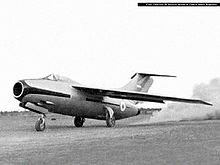
Picture - Pulqui II on takeoff
After the end of the war, Kurt Tank, in exile in Argentina, continued the Ta 183 project, resulting in the IAe Pulqui II. This version was modified to place the wings at a shoulder-mounted position, in order to avoid a heavy fuselage spar pass-through structure going around the engine, which resulted in deep stall problems at high angles of attack. This seemed solvable, however, and a newer version correcting these problems was planned. However, the financial crash of 1953, and the fall of Juan Peron, ended the project temporarily; by 1955, the project was permanently shut down. The final nail in the coffin for the Pulqui II project was the cheap availability of surplus combat proven F-86 Sabres from the end of the Korean War, at a fraction of the cost of the troubled and expensive Argentine aircraft.
Another aircraft to be indirectly influenced by the Ta 183 was the SAAB Tunnan. SAAB engineers received German research studies in swept wings in the immediate post-war period via contacts in Switzerland, and incorporated it into the Tunnan design, which was still limited to paper studies at the time. The start of a series of jet fighter aircraft from Sweden, the Tunnan served into the 1970s.
Specifications (Ta 183, as originally designed)
General characteristics
Crew: one
Length: 9.20 m (30 ft 2 in)
Wingspan: 10.00 m (32 ft 10 in)
Height: ()
Wing area: 22.5 m² (242 ft²)
Empty weight: 2,380 kg (5,247 lb)
Loaded weight: 4,300 kg (9,480 lb)
Powerplant: 1x— Heinkel HeS 011 turbojet, 13 kN (2,700 lbf)
Performance
Maximum speed: 955 km/h (593 mph)
Service ceiling: 14,000 m (45,932 ft)
Rate of climb: 20.4 m/s (4,020 ft/min)
Wing loading: 196 kg/m² (41 lb/ft²)
Thrust/weight: 0.37
Armament
4 x— 30 mm (1.18 in) MK 108 cannons
4 x— Ruhrstahl X-4 Wire Guided AAMs or 500 kg (1,102 lb) of bombs
Related development
FMA IAe 33 Pulqui II
Comparable aircraft
Lavochkin La-15
Mikoyan-Gurevich MiG-15
Messerschmitt Me P.1101
North American F-86 Sabre
Saab Tunnan
Bibliography
Gordon, Yefim. Mikoyan-Gurevich MiG-15: The Soviet Union's Long-Lived Korean War Fighter. Earl Shilton, Leicester, UK: Midland Publishing Ltd., 2001. ISBN 1-85780-105-1.
Myhra, David. Focke-Wulf Ta 183 (X Planes of the Third Reich). Atglen, PA: Schiffer Publishing, 1999. ISBN 0-76430-907-6.
Living Warbirds: The best warbirds DVD series.
Source: WikiPedia